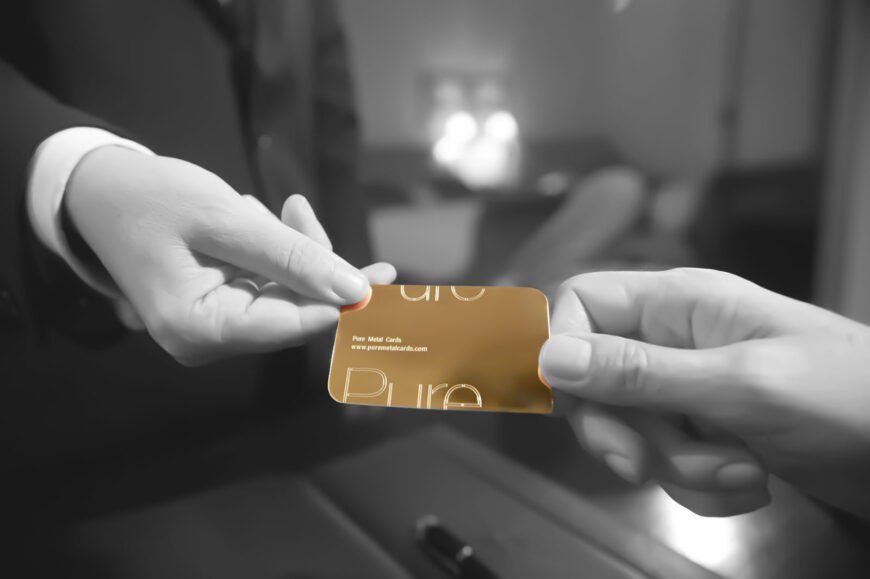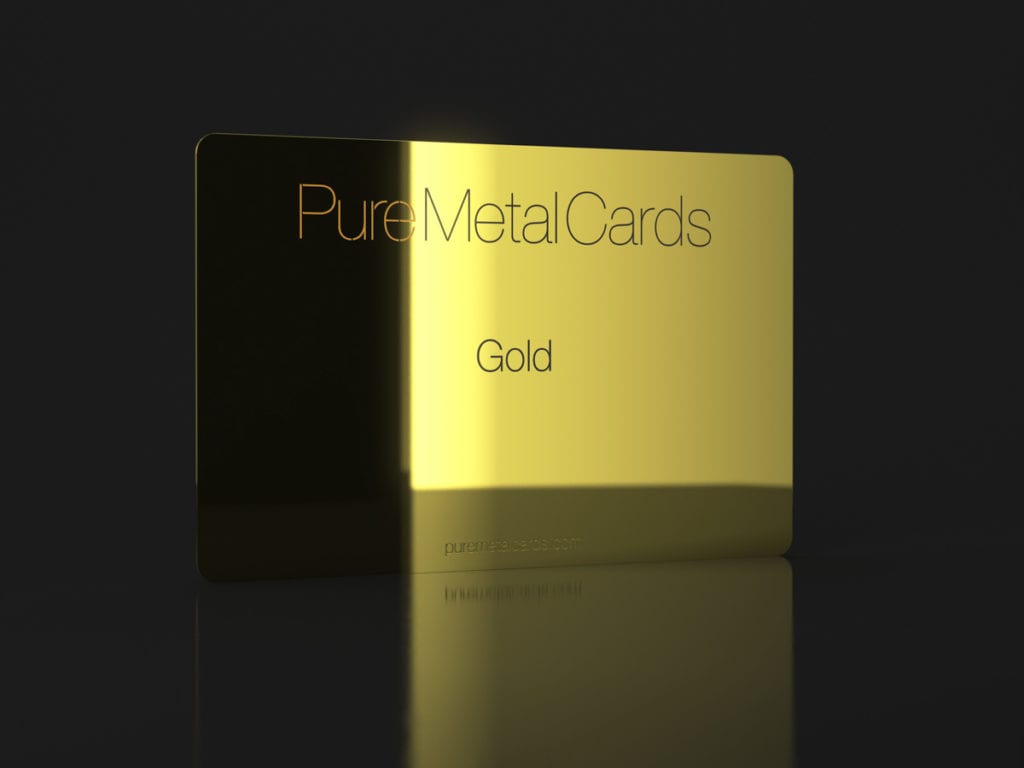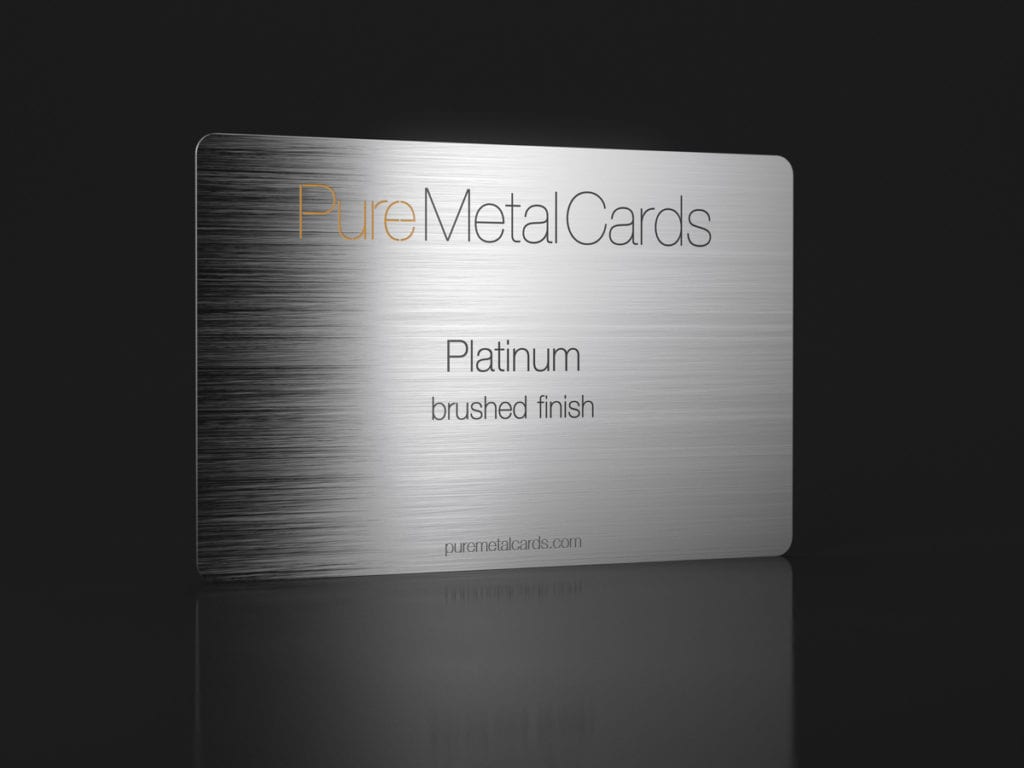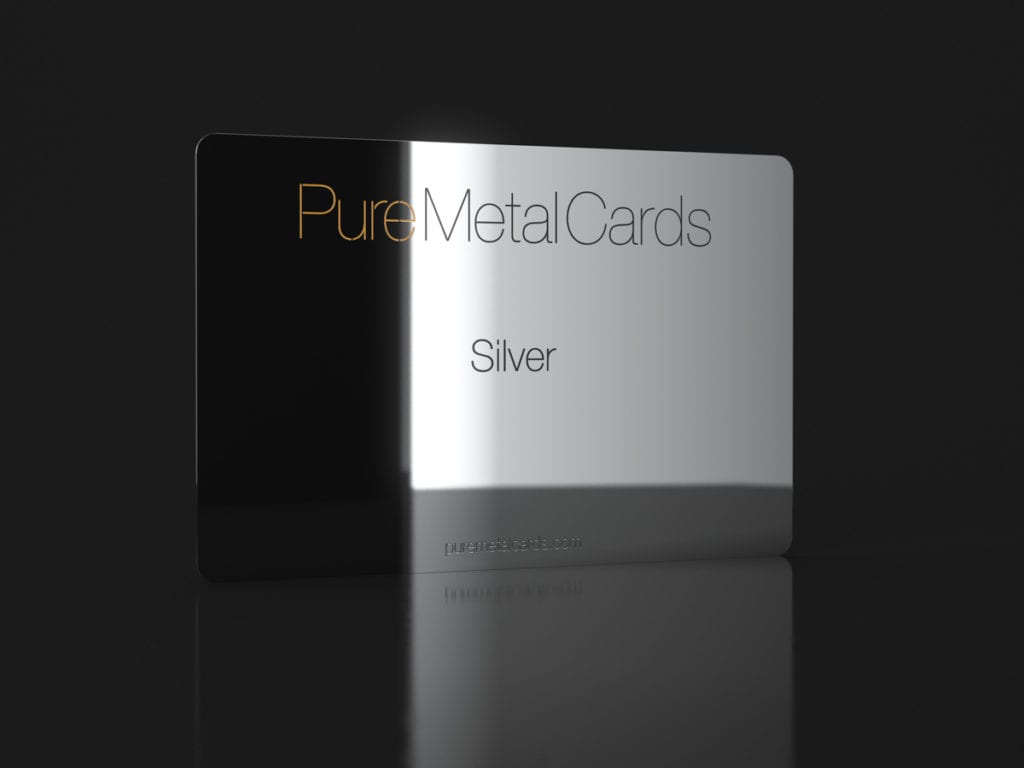Be extraordinary with Pure Metal Cards. Our team of designers, craftsmen, and craftswomen can help transform your visions into a masterpiece that is a true reflection of your individuality. Our precious metal cards are the ultimate way to make your mark. Each card is individually crafted to your specifications.
This article describes the characteristics of the three precious metals we offer along with tips for their care. By understanding these characteristics, you’ll be able to purchase your made to order precious metal cards with confidence.
Gold is an extraordinary and rare precious metal, with an unmatched combination of chemical and physical properties. It is the only yellow metal. Gold is the most non-reactive of all metals and it does not oxidize under ordinary conditions, meaning that it will never rust and never tarnish. Gold’s physical properties of high electrical conductivity and chemical inertness make it an excellent and reliable conductor, particularly in harsh environments, where temperatures can range from -55°C to 200°C. No other metal is as malleable as gold. A single ounce of the metal can be drawn into a wire five miles long. Gold is also an excellent conductor of thermal energy. Due to all these specialties, gold is used in various other industrial applications along with jewelry manufacturing.
Gold Purity
Gold’s purity is measured in karats. The term ‘karat’ is different from the term ‘carat’, which is used to measure weight in gemstones. The purity of gold in karat determines its value.
Pure gold is very soft and pliable, and alloys of different precious metals are combined with pure gold to enhance its durability and strength, as well as creating a blush in the gold’s appearance with different color tones. 24 karat is 100% pure gold and is more expensive and less durable than gold that is alloyed with other metals.
Gold purity for the mostly used karats:
24 Karat – 24K Gold with 100% purity
22 Karat – 22K Gold with 91.6% purity
18 Karat – 18K Gold with 75% purity
14 Karat – 14K Gold with 58.33% purity
12 Karat – 12K Gold with 50% purity
10 Karat – 10K Gold with 41.67% purity
24 karat gold is soft pure gold without any alloys and it has a deep yellow color and a rich luster. Gold of lesser karats (22K-10K) is all alloyed with a combination of silver, copper, nickel, and zinc. This adds strength, but if too much is added (in the case of 10K and less) it can dull the color. For both durability and beauty, we recommend using 14K or 18K for your cards.
Gold Color
In its pure form, gold has a metallic luster with deep yellow in color, but when mixed or alloyed with other metals, such as silver, copper, zinc, nickel, platinum, palladium, etc. then it creates various color hues like white, pink/rose, green and the seldom found blue, purple and black.
- Yellow Gold Yellow gold is the most frequently seen and timeless color. It is usually alloyed with silver and copper. Depending on the karat gold (14K, 18K or 22K), the color of yellow gold may vary from a softer shimmering yellow to a bright rich yellow. This is due to the varying alloy combinations. The color contrast of yellow gold is most suitable to diamonds and other delicately colored gemstones, as they can appear brilliant and vivid.
- White Gold White gold is harder than yellow gold with a bright lustrous white color. It is most commonly alloyed with a significant percentage of silver or a mixture of other white precious metals. Palladium and nickel are other precious metals that are alloyed to create white gold. Due to the presence of nickel in the white gold alloy, it tends to be harder than yellow gold. The percentage of gold naturally varies, according to the quantity of additional precious metal, which is included in the formulation of the alloy. White gold is highly reflective and not subject to tarnish.
- Pink or Rose Gold Pink / Rose gold is alloyed with copper, and at times possibly even with silver. The proportions are about three parts of 24-karat gold to one part of copper. These alloys blush and accentuate the gold with a pink hue, which varies in color depending upon the amount of copper blended with the pure gold. The quantity of copper determines whether the gold is pink or more rose-colored in tone and highlights. 18K Pink/Rose Gold is composed of 75% fine gold and 25% copper.
- Gold Plate Gold Plate refers to a thin layer of plating of 10-karat gold or better which has been bonded to a base metal. The karat gold content may be less than 0.05%, but it must be properly identified by weight in terms of total metal content. Our gold plated cards are also available.
Platinum is an extremely rare metal, even rarer than gold. Due to its rarity, it is also an expensive metal and it has only been found in a few locations worldwide – Russia’s Ural Mountains, South Africa’s Merensky Reef and a few small mines in North America.
Platinum is a strong, dense metal, which allows it to be used in many different ways. Platinum is used in jewelry, laboratory equipment, electrical contacts, dentistry, and automobile emissions control devices. The word platinum comes from the Spanish word ‘Platina’, meaning ‘Little Silver’.
The annual worldwide production of platinum amounts to some 160 tons, compared to about 1,500 tons of gold. The mining and refining processes are both difficult and time-consuming. For example, to extract a single ounce of platinum, about 10 tons of ore need to be mined. This process of refining takes a full five months.
Platinum used in our cards is an alloyed group of six heavy metals, including platinum, palladium, rhodium, ruthenium, iridium, and osmium.
Platinum Purity
Platinum, with its beautiful white luster, is the purest of all the precious metals used for our cards and fine jewelry. This grayish-white to silver-gray metal is harder than gold and very durable with a hardness of 4-4.5 on the Mohs hardness scale, equivalent to the hardness of iron.
Platinum purity is expressed differently than gold. Instead of expressing purity in ratios of 24 parts, platinum standards are expressed as units of 1,000 parts. The most regular platinum purities seen are:
950 – 95% pure platinum
900 – 90% pure platinum
850 – 85% pure platinum
Platinum is often alloyed with copper and titanium. As compared to gold, platinum requires very little alloy to be combined with it to make platinum cards. It’s the only precious metal used in fine jewelry that is 90% to 95% pure, largely hypoallergenic, and tarnish-resistant. Platinum maintains its color, brilliance, and weight even when scratched, while other metals may lose their luster or become blemished or discolored.
Platinum vs Gold
Although platinum is quite a new metal as compared to gold but due to its unique properties, it is getting popular very rapidly. Despite its strength, platinum is a very flexible and workable material, making intricate designs and details far easier to achieve than with gold.
Platinum is also a very dense and heavy metal, so a platinum card will feel heavier than an 18kt gold card for example. Platinum is, however, significantly more expensive than gold. Platinum is extremely long-wearing and is very white, so it does not need to be rhodium plated as white gold does.
Silver has been known and used for thousands of years and it is considered as one of the three precious metals along with gold and platinum. Pure silver is a very soft metal with its lustrous white color. Although it is harder than gold and much more plentiful, but still too soft in its natural state and required to be mixed with a harder metal for the use in our card manufacturing. It ranks second in ductility and malleability to gold. It is normally stable in pure air and water but tarnishes when exposed to ozone.
Silver is the brightest reflector of any metal (except for liquid mercury) and can be polished to a high sheen that even platinum can’t achieve. It has also the highest electrical and thermal conductivity of all metals, even higher than copper. Most silver is produced as a by-product of copper, gold, lead, and zinc mining. Commercial-grade fine silver is at least 99.9% pure silver and purities greater than 99.999% are available. Mexico is the world’s largest silver producer which contributed 15% of the annual production of the world. Canada, Peru, Australia, and the USA are the other major countries producing silver.
Silver Purity
The purity of silver is based on the other metals, which are available in the silver in the form of metal alloys. Unlike gold, but like platinum, silver purities are expressed as units of 1,000 parts. Based on its purity, it can be described as below:
- Pure/Fine Silver It is the purest form of silver with 99.9% purity. It is also known as fine silver. In this form, silver is too soft to use for jewelry or cards.
Purity – 999 points (99.9% pure silver) - Sterling Silver Due to the softness of pure/fine silver, it cannot be used in its purest form for jewelry.or cards. Therefore, to give strength and durability to the pure silver, it is alloyed with other harder metals, usually copper. A mixture of 92.5% of pure silver and 7.5% of copper is known as sterling silver. Sterling silver is one of the most familiar and used forms of silver alloys. Purity is 925 points (92.5% pure silver)
Metal Care
Precious Metals are hard enough and durable but due to our day-to-day activities, it is expected that our precious metal cards may get dirty or scratched. Proper care of these cards is essential to use it for a lifetime.
Here are some tips that will help you to preserve the life and luster of precious metals like gold, platinum or silver:
Cleaning of Your Precious Metal Cards
Your precious metal card may become dirty over time due to contact or oxidation (contact with air). If you are cleaning your precious metal card it should only take a few minutes to clean. Regular cleaning of precious metal cards is essential to maintain the shine of the metal:
- Clean regularly your gold, platinum and silver card with soap, water, and a cloth or soft brush, if needed. Simply make a bowl of warm water with a very mild detergent and gently place your card in the mixture. After cleaning, be sure to dry it thoroughly with a soft cloth. Clean tarnished silver with a commercial polish, paste, or tarnish-removing wipe.
- You can also use jewelry cleaners for your precious metal cards which are sold by many department stores. You can find these jewelry cleaners in kit form. You just need to follow all the written precautions and instructions for cleaning.
- Any grease is removable by dipping the card in any type of alcohol.
- If a silver card becomes tarnished, use a paste, liquid polish or a treated polishing cloth to restore its original luster.
Storing of Precious Metal Cards
Storing your precious metal card is also important. Storage of precious metal cards requires the following precautions:
- One of the best ways to store your precious metal card is in a velvet box or tissue paper. Make sure the metal is dry and is stored in a cool, dry environment.
- Precious metal cards should be stored in a fabric-lined jewel case or a box with compartments or dividers.
- Avoid storing your precious metal card directly on wood or plastic.
If you follow the above mentioned caring tips your precious metal card will always shine and luster like a new one.
For further details on specifications pricing of our made to order precious metal cards can be found for gold cards, platinum cards, and silver cards.
Why Choose Pure Metal Cards?
Speed – Pure Metal Cards offers the fastest turnaround time in the market today for custom-made metal business cards. Cards typically take 7-9 business days to produce and 1-2 days to ship to you.
Pricing – We lead the industry by offering simple, all-inclusive pricing. The price quoted on our website is the price you pay.
Range of Card Finishes – We offer the widest range of metals and card finishes available anywhere. For example, we have 21 different finishes for our stainless-steel cards.
Customization and Personalization – To customize your metal cards we offer a range of options to make each card traceable.
Client List – Pure Metal Cards works with a wide range of clients ranging from globally renowned brands to start-ups and fledgling businesses across all industries and continents.
Satisfaction Guaranteed – We want you to be completely amazed by your purchase. We replace cards if they do not meet your satisfaction.
Switch to Pure Metal Cards Today
With over 2 million metal cards shipped to over 70 countries around the world to date, we lead the industry in card innovation and options to make your name or brand stand out from the rest. Pure Metal Cards can help you develop your existing business card or membership card to become an unforgettable metal card your clients or members will enjoy receiving. A Pure Metal Cards precious metal business card or member card will ensure your name will be unforgettable.
For more information please contact us today.




